Some of the links in this post may be affiliate links.
Did you know that the vanilla bean we use in cooking actually comes from an orchid and that you can grow this plant indoors? Vanilla planifolia, commonly known as the vanilla bean orchid, can be easily grown indoors in your home or in a greenhouse.
Keep reading to learn how to grow vanilla orchids indoors. I will share with you my personal experiences with the plant, and you will learn some other interesting tidbits as well.
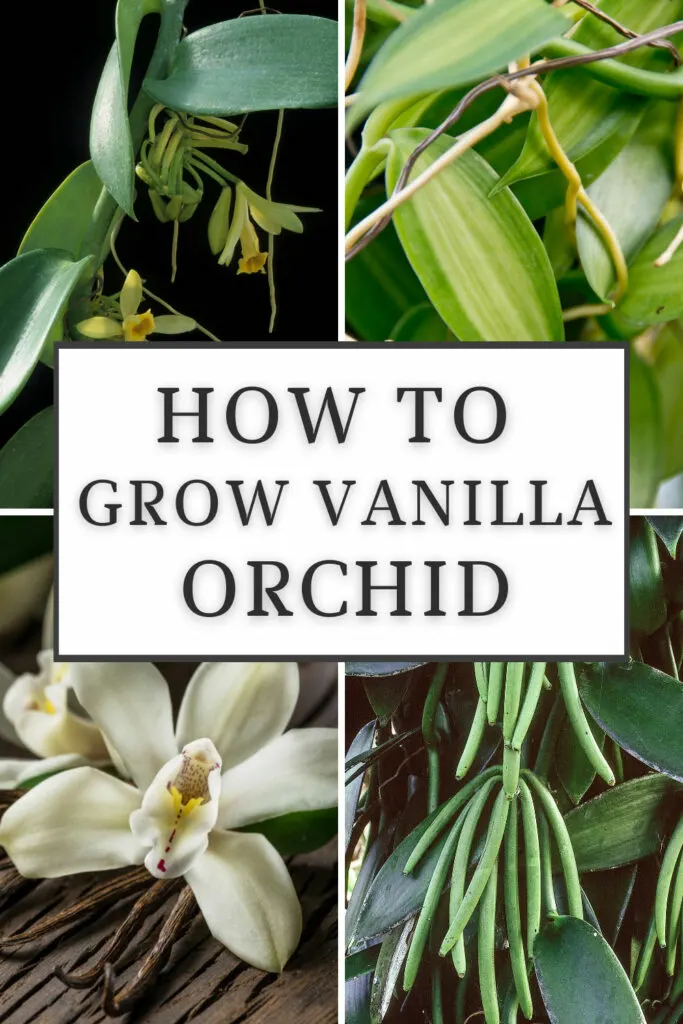
And with time, patience, and good care, you may even be able to grow your own vanilla beans!
Table of Contents
Table of Contents
ABOUT VANILLA BEAN PLANTS
Before I go into how to grow the vanilla orchid, here are some fascinating facts about this extraordinary, commercially valuable plant.
- There are 119 accepted species of vanilla orchid, with V. planifolia being the primary source of natural vanilla flavoring.
- The plant is indeed a member of the orchid family, and its native habitat ranges from southern Mexico, through much of Central America and Brazil.
- Much of the world’s commercially grown vanilla comes from Madagascar and Indonesia, though it is also grown in China, Mexico and other countries.
- Vanilla is said to be the second most expensive spice, second only to saffron because of the intensive labor and time that is required to produce a crop.
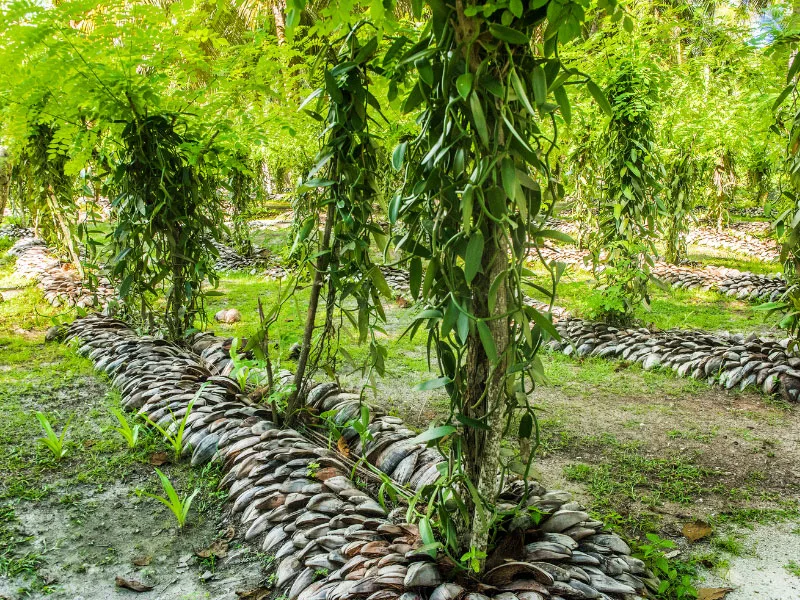
- Because of the high cost of natural vanilla, synthetic vanilla is often used in foods, drinks, and also pharmaceuticals. A compound called vanillin is the main component in vanilla extract, and synthetic vanillin has been developed as an alternative to natural vanilla.
- Natural vanilla flavor is produced when vanilla beans are dried and cured by steaming and fermentation.
- In 1836, it was found that the melipona bee, a tiny bee that is endemic to Mexico, is the sole pollinator of the vanilla plant. Outside of Mexico, commercial plants need to be pollinated by hand.
- The vanilla flower lasts less than a day (approximately 8 hours), so time is of the essence when it comes to pollinating!
- The vanilla orchid is a vining plant, unlike the vast majority of other orchid plants.
- The vanilla plant is considered a semi-epiphyte. This means that it can grow as an air plant on a tree, or terrestrially in the soil as well.
- Vines can grow 100 feet or more outdoors, but will be much smaller indoors.
HOW TO GROW VANILLA ORCHID
If you want to eventually grow your own vanilla bean pods, here are some important considerations and care tips for your plant.
1. LIGHT
Indoors, this tropical plant requires at least half a day of direct sun. An unobstructed Eastern or Western facing window works well. Despite what you may have read in some sources, some direct sunlight is very important indoors for the best growth.
My own vanilla orchid was growing indoors in front of an Eastern facing window for a few years before I moved it into my greenhouse.
If you live in an area with very strong sun, you may want to avoid mid-day sun, but otherwise, even your sunniest window would work very well.
Assuming your plant has reached blooming size, without sufficient bright light, your vanilla orchid will refuse to flower, so if you have complete shade indoors, it is probably best to avoid growing this plant if you’re hoping for flowers one day.
Your vanilla vine will greatly benefit from spending the summer months outdoors and will reward you with more vigorous growth. Just be sure that you harden off your plant properly so it doesn’t burn outdoors.
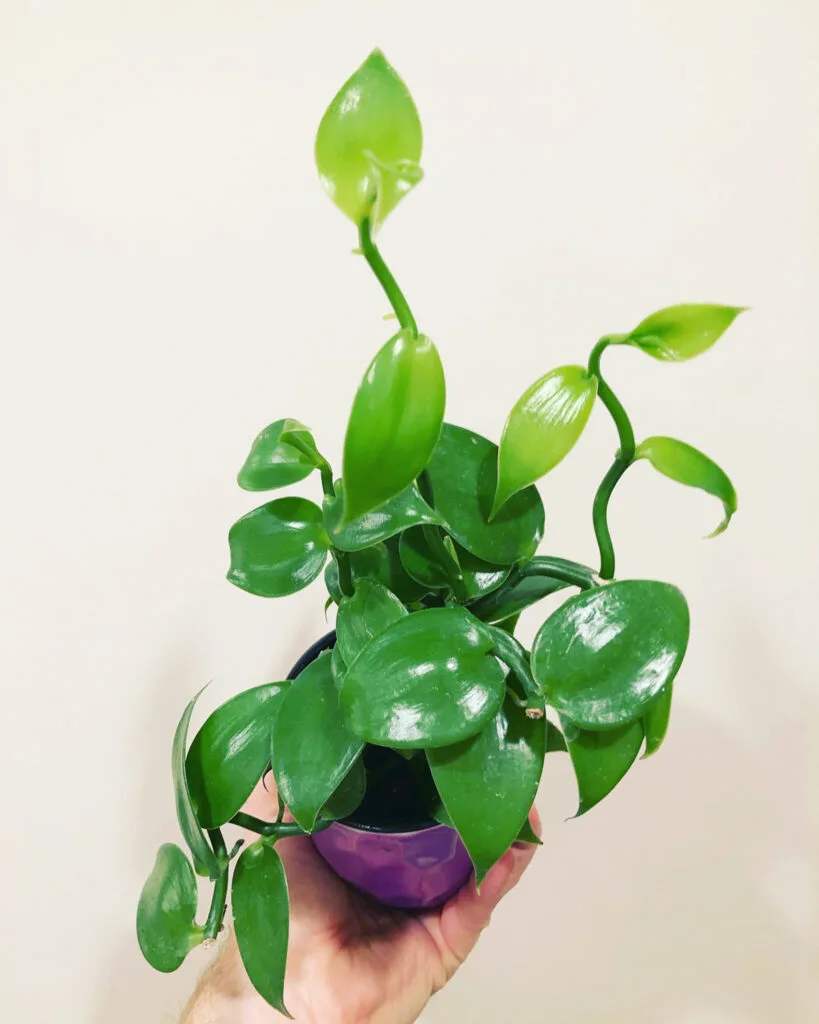
2. WATERING
Vanilla orchids need sufficient moisture in order to grow well. Do not allow them to dry out completely for too long.
Do allow the potting medium to dry out a bit before watering again thoroughly though. I would recommend letting the top quarter of the potting mix to dry out before watering thoroughly again.
This will go a long way in helping to foster a healthy root system.
And while you’re at it, if you see any aerial roots on the plant (they will eventually grow), mist those exposed roots as well so that they don’t shrivel up.
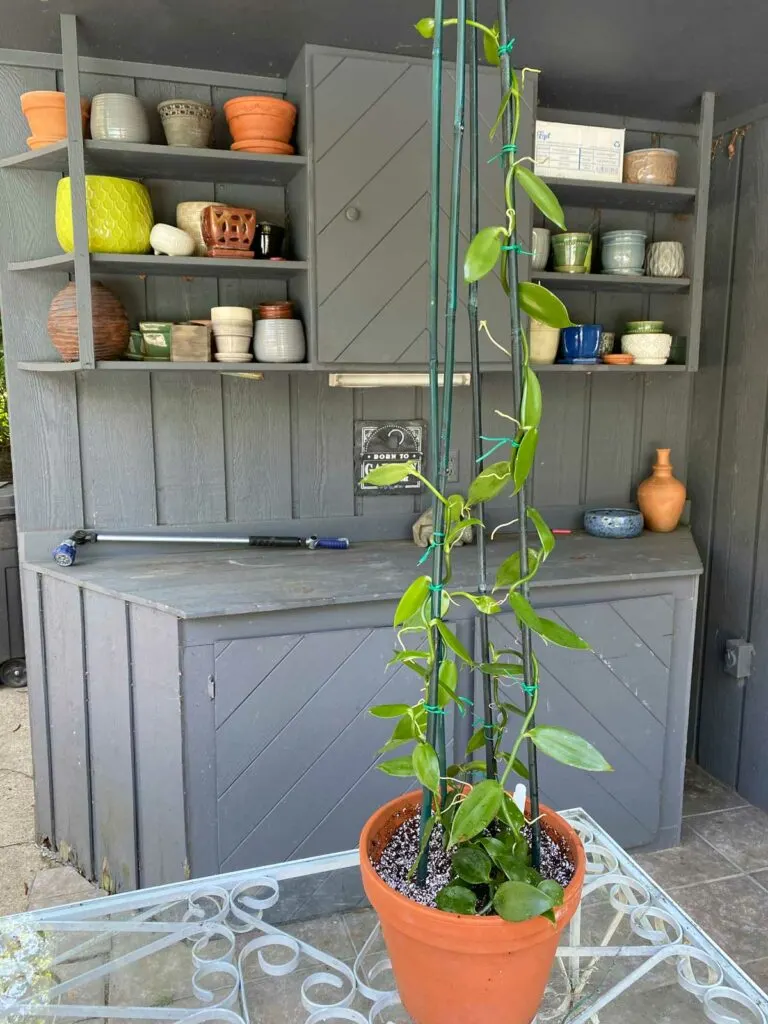
3. POTTING MEDIUM
There are many different potting media that you can use for growing your vanilla orchid plant, and while many orchids can grow in plain orchid bark, you should avoid this for your vanilla orchid because it simply doesn’t hold enough moisture.
When I first got my small plant, it was growing in sphagnum moss. When I repotted it, I changed the growing medium.
I’ve had success with equal parts all-purpose potting mix, orchid bark and perlite. This provides sufficient moisture retention, while allowing plenty of air to the root system as a result of the chunky structure of the potting blend.
4. POT TYPE
You can use any kind of pot, but I’ve had best results with terra cotta pots. The porosity of terra cotta pots will great diminish the risk of root rot for these semi-epiphytic plants.
It becomes especially important as you go into larger pot sizes.
5. SUPPORT STRUCTURE
The Vanilla orchid is a vining plant and it will grow very large, so this is definitely not a plant for small spaces. From pretty early on, you should provide a support structure, and as it grows, you’ll need a pretty large one.
My own plant started off with a single bamboo stake as a support structure. As it grew taller, I made a tripod out of longer bamboo sticks as you saw in a previous photo.
Then finally, when I got my greenhouse, I made an 8-foot tall square climbing structure out of bamboo. I used 4 thick, 8-foot-long bamboo posts for the corners, and then cut pieces of bamboo to make horizontal rungs.
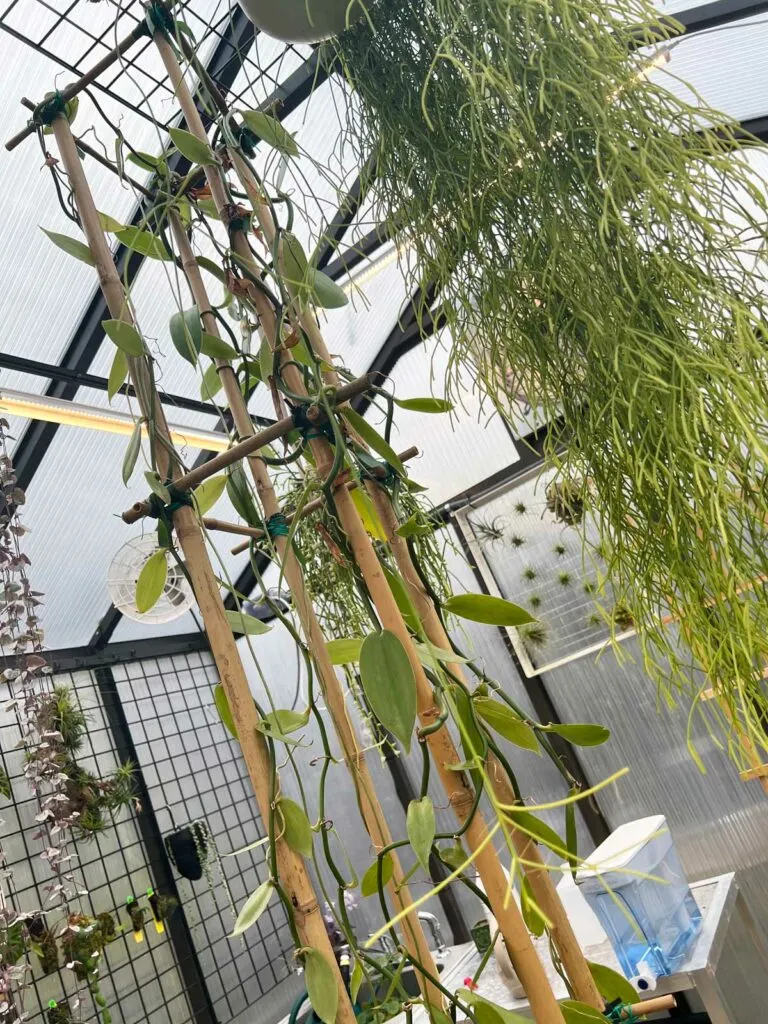
I trained them by loosely tying the vines, but then their aerial roots will start to grow and attach to the supports. After the plant grows all the way up the support, the vines will trail down. Once they reach the surface of the soil, you can train them back vertically upwards.
You can also train your vanilla orchid to grow around the perimeter of your room or greenhouse, assuming that you have enough light.
In nature, plants will start growing at the base of a tree. They will attach themselves to their host trees via their aerial roots, and start rambling all over the trunk and branches.
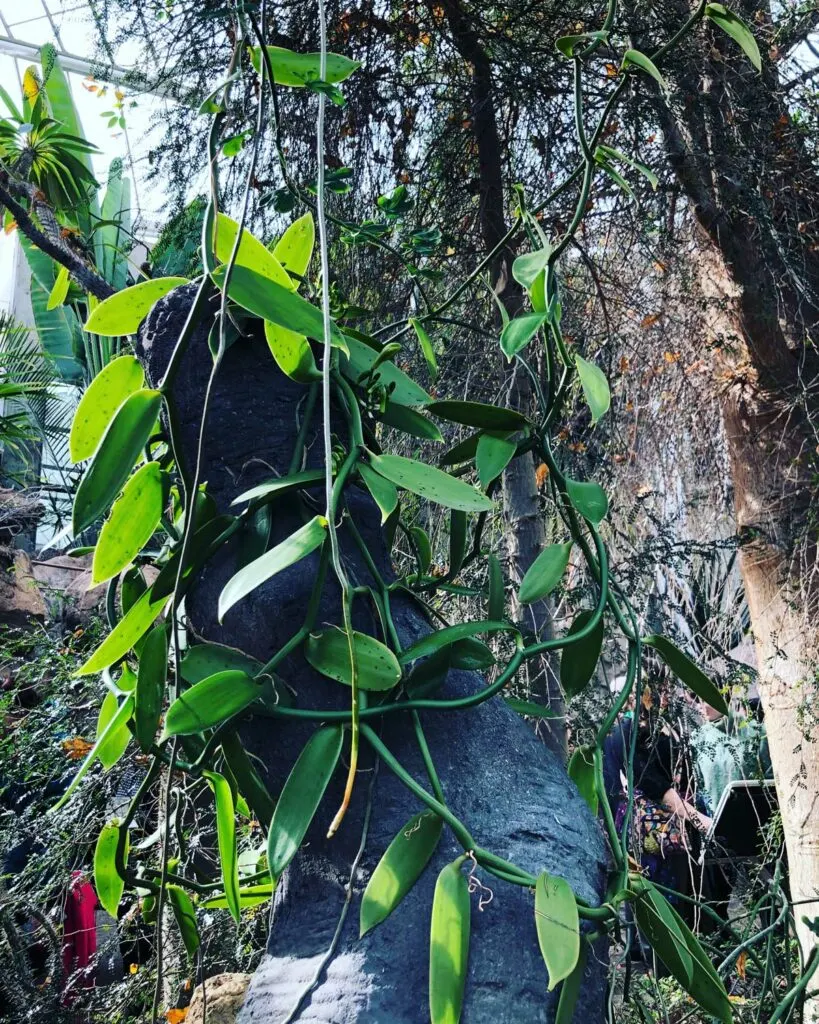
6. FERTILIZING
The recommended fertilization for vanilla orchid is light, but consistent throughout the growing season.
I use Dyna-Gro Grow (link to Amazon) which has a 7-9-5 NPK ratio. I use 1/4 to 1/2 teaspoons per gallon of water at each watering.
In the dead of winter when my plant is not growing much, I’ll refrain from fertilizing until warmer temperatures and more light return as days get longer in late winter to early spring.
I use Dyna-Gro Grow for all my indoor plants and have seen a wonderful difference in their health and growth!
7. TEMPERATURE & HUMIDITY
Warm temperatures and high humidity are a must for growing the vanilla orchid!
The absolute bare minimum temperature is 55°F (13°C), though a minimum of 60°F (16°C) is better. Vanilla orchids suffer with cooler temperatures and can develop yellow leaves and potential root issues.
Growing temperatures of 70-90°F (21-32°C) are ideal and will be most beneficial for growth and development.
Plants will benefit from high humidity, and this will also keep the aerial roots in good condition.
The only practical way to increase humidity is to use a humidifier in the home, or if you are a greenhouse owner, maintaining high humidity is no issue.
Indoors, since these plants climb and get very large, a humidity tray or pebble tray really isn’t practical.
8. AIR CIRCULATION
Like any orchid species, good air circulation is important for your plant’s health for good growth as well as to help avoid fungal diseases. A gently circulating fan should do the trick.
9. PROPAGATION
The orchid nursery Carter and Holmes recommends propagation by cuttings, but only from plants that are at least 20 feet or more in length.
The sap from the vanilla vine stems or roots can be irritating to your skin, so wear gloves when making your cuttings. If the sap has contacted your skin, be sure to wash your hands with soap and water.
Carter and Holmes has a great guide with pictures showing exactly how to propagate your vanilla orchid cuttings.
10. VANILLA ORCHID FLOWERS & SEED PODS
Vanilla orchid plants will flower after 3-4 years or so, but only under ideal conditions. Indoors, they would often take longer, and may never even flower indoors unless they’re happy. If you can grow your plant in a warm, bright greenhouse, you will greatly increase your chances of flowering and fruiting.
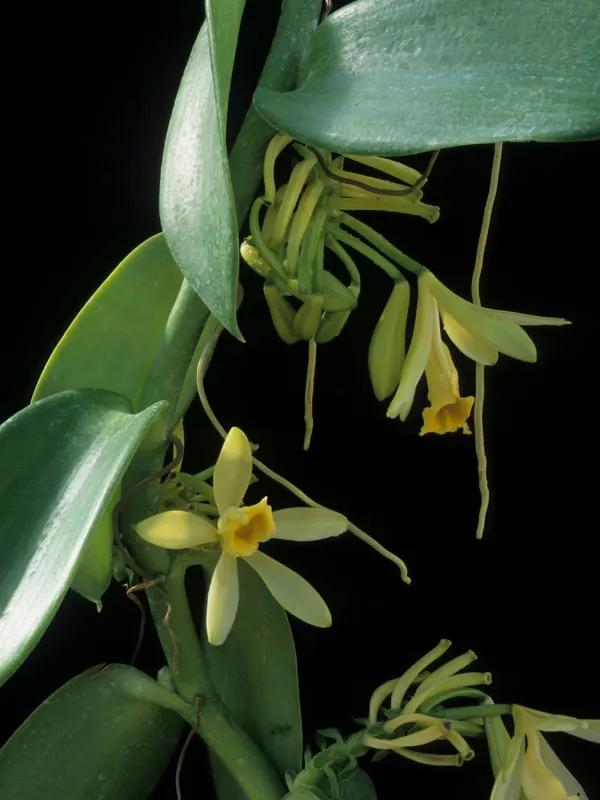
Here are some interesting tidbits to consider concerning getting your plant to flower:
- Plants usually need to get very long before they start to flower, often even 30 feet or longer.
- A dry period of a couple of months in the winter months is important to initiate flowering, assuming the plant is of mature size. In its natural habitat, flowering takes place typically around April and May near the end of the dry season.
- The fragrant flowers have only a light scent, and they appear only once a year over a period of about two months.
- It is said that if your vanilla orchid vine climbs up your support structure and starts to cascade off the top of the support, this will help to encourage flowering.
- Multiple flowers will emerge from the leaf axils, with each individual flower lasting only about 8 hours or so.
Check out an article by the American Orchid Society on pollinating vanilla orchid flowers as a starting point. You’ll need to hand-pollinate your flowers otherwise your plant will not produce any vanilla beans.
Pollination is typically done with a toothpick. It is tricky because you have to lift the rostellum so that the anther can then be rubbed against the stigma.
If the pollination was successful, the skinny vanilla bean pods will start to grow over the next couple months or so. The pods will stay on the plant for at least 8-9 months.
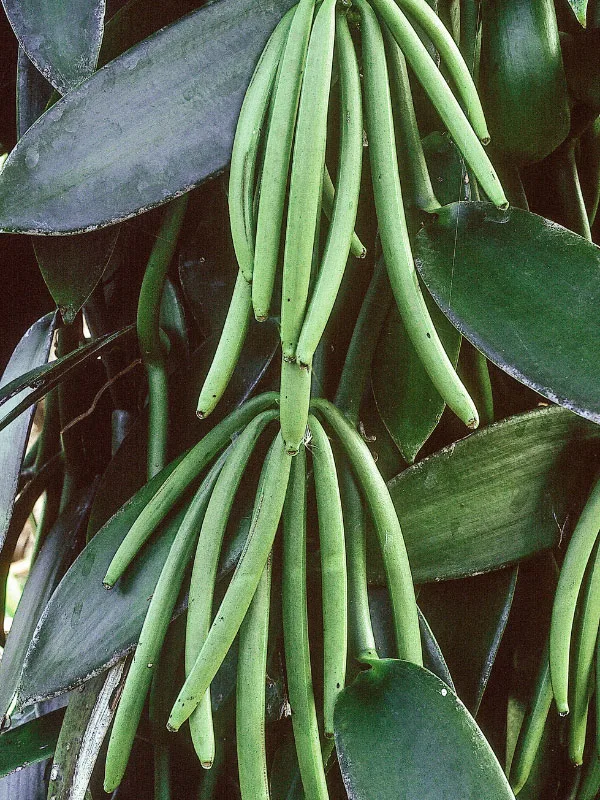
Each skinny fruit pod reaches about 6-9 inches in length
After the pods are picked, you’ll have to cure the vanilla beans.
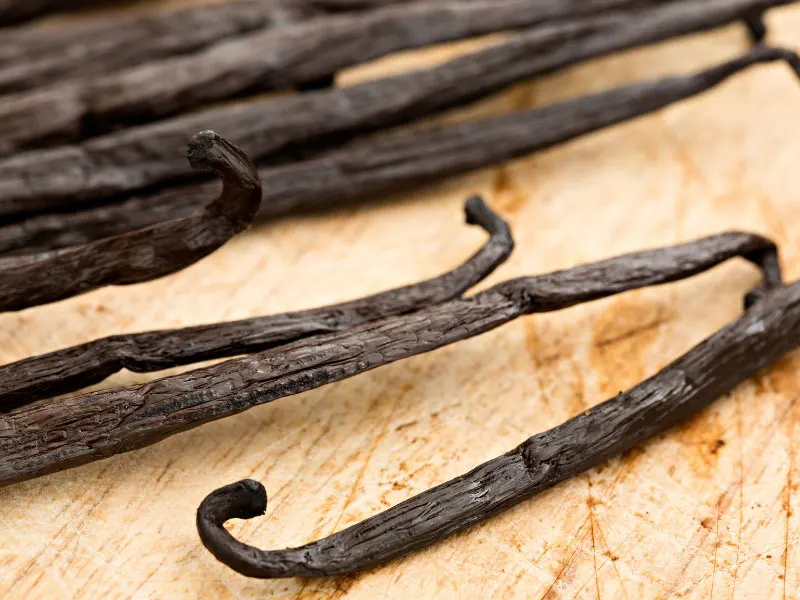
I hope you’ve enjoyed this post on how to grow vanilla orchid. Do you have a vanilla orchid? Comment below. I’d love to hear!

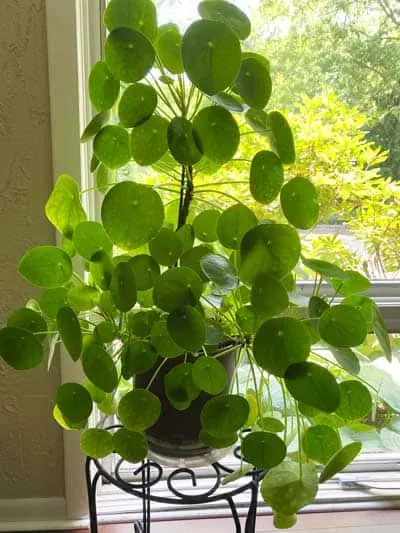
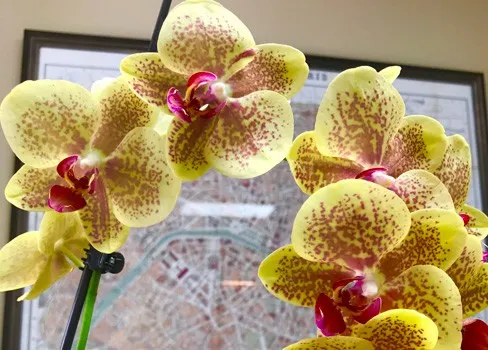
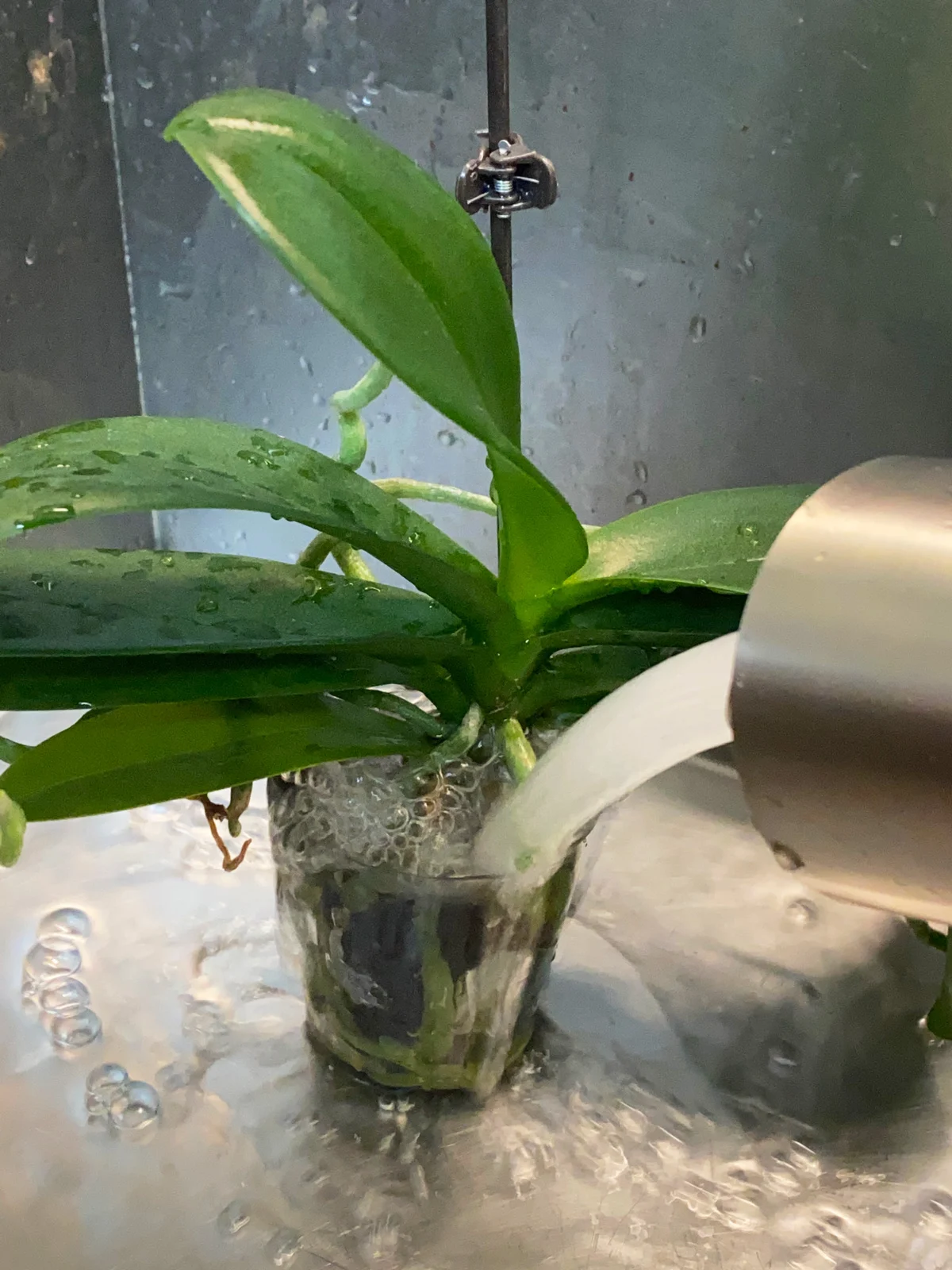
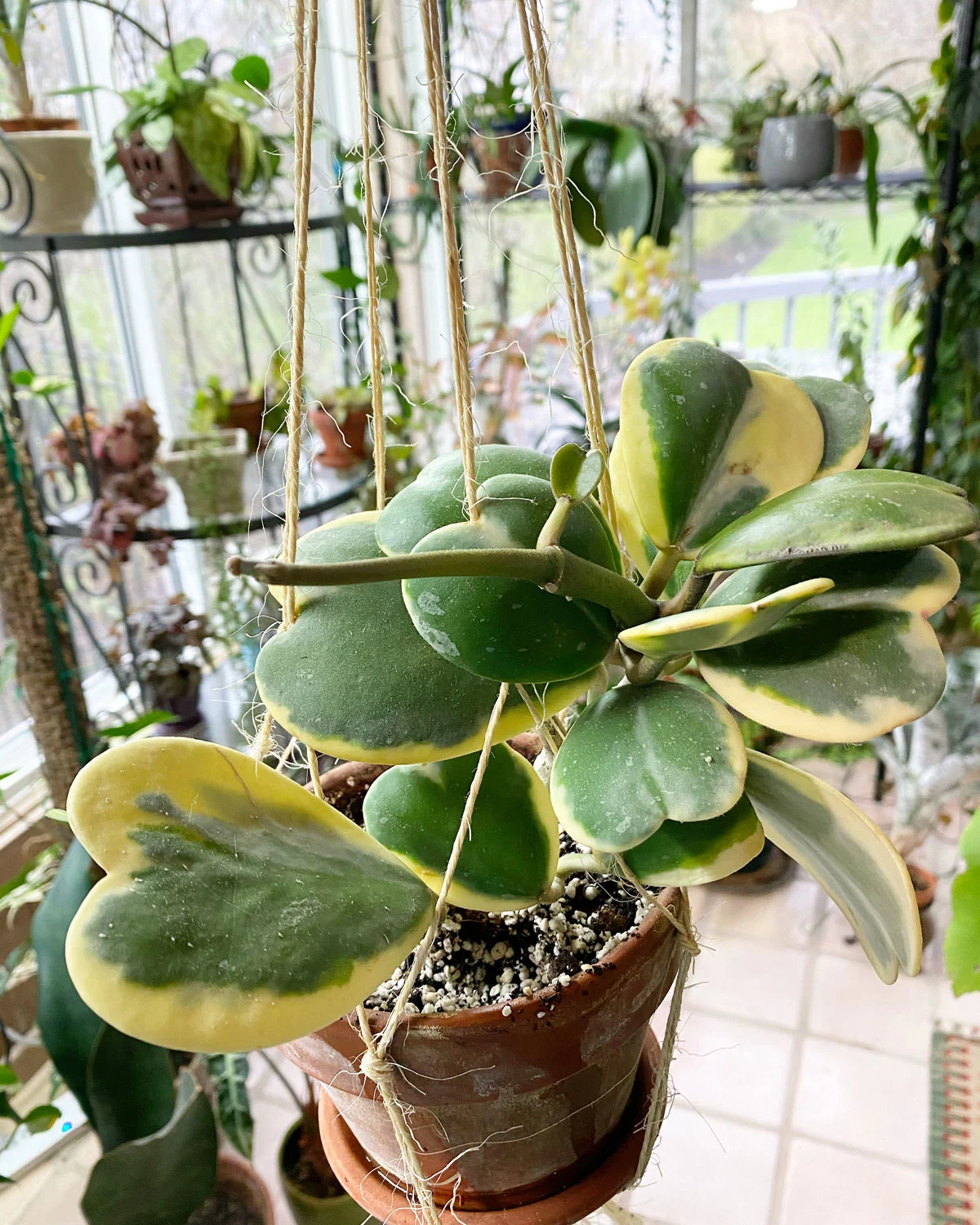
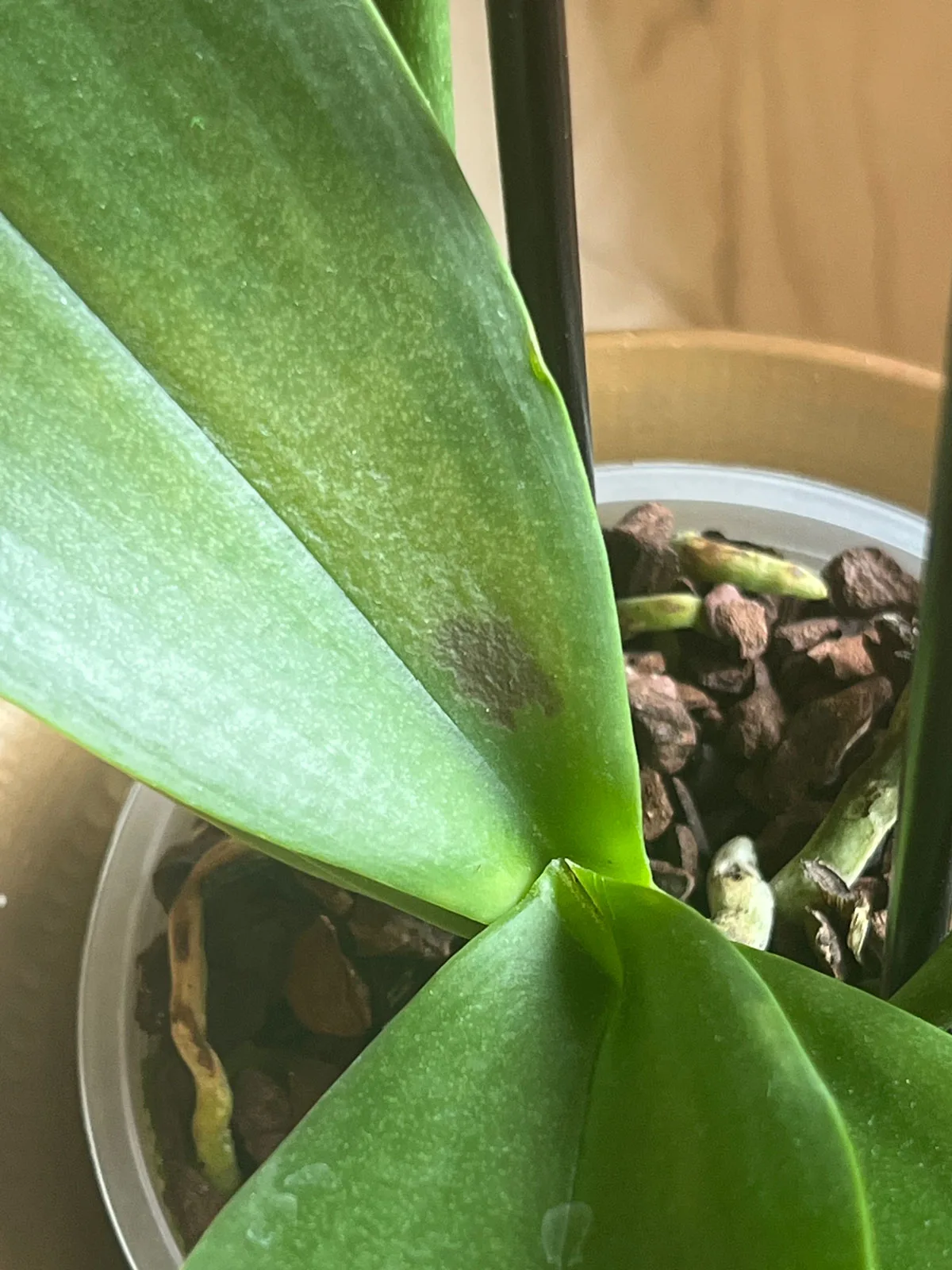
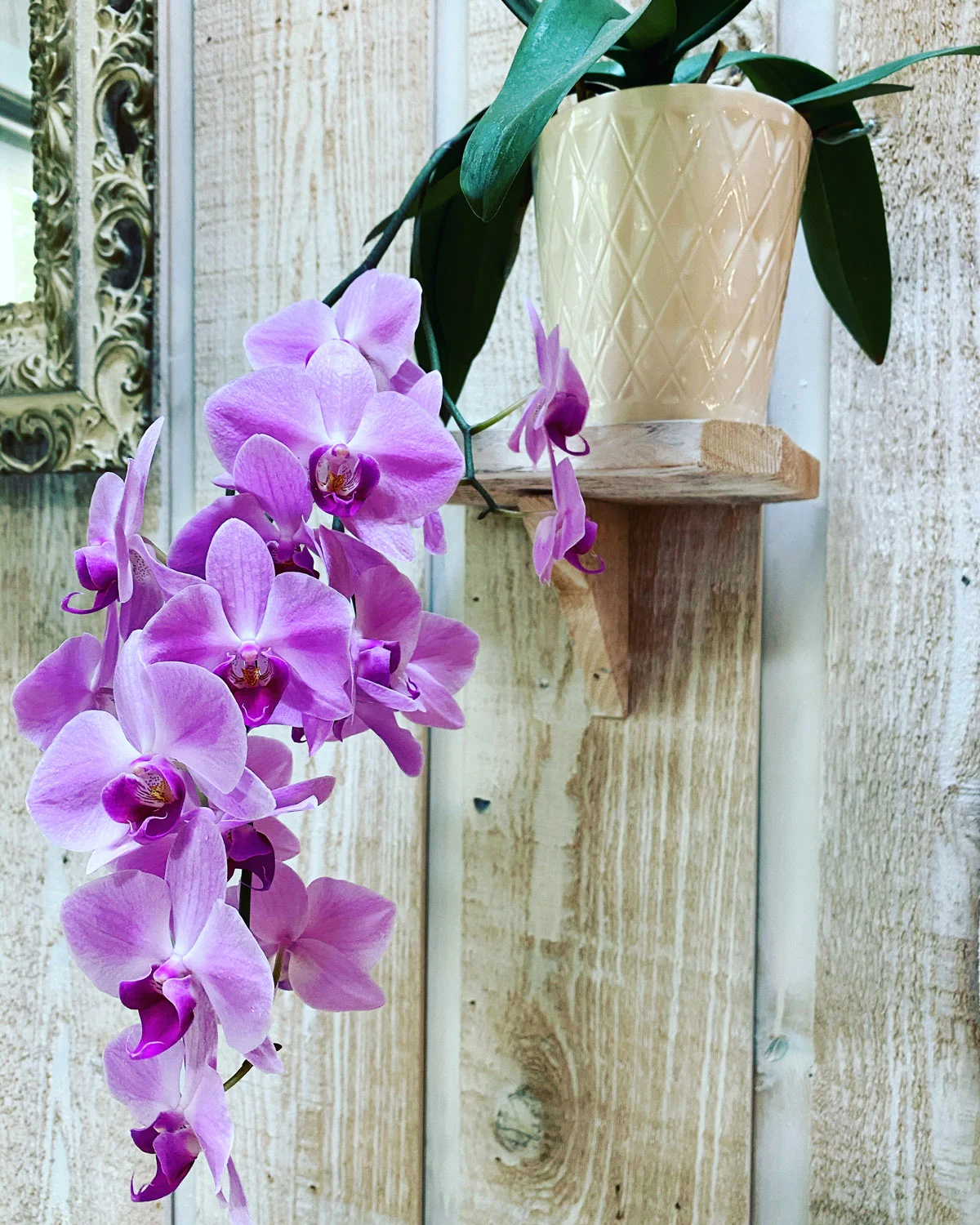
Cindy
Tuesday 20th of May 2025
My vanilla orchid suffered over the winter. I moved it a couple months ago. There is still life in it…. Barely! The vines look alive but I snipped off LOTS of dead leaves, trimmed a couple vines and now not sure what to do. I REALLY want to replant it. My husband bought it for me a couple yrs ago and paid WAY too much! Lol 🥰. I really need some help! Thank you! And your greenhouse is AMAZING!
Raffaele Di Lallo
Wednesday 21st of May 2025
Hi Cindy! Can you send me some photos so I can look at it? If you're on Instagram, you can DM me (@ohiotropics) or send through Facebook Messenger to my account there (Ohio Tropics Houseplant and Garden Care)